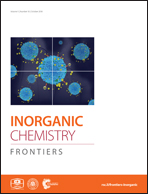A facile synthesis of porous N-doped carbon with hybridization of Fe3C nanoparticle-encased CNTs for an advanced oxygen reduction reaction electrocatalyst†
Abstract
A facile synthesis of N-doped porous carbon hybridized with N-doped carbon nanotubes encapsulated with Fe3C nanoparticles (FeNC-ZIF-800) by simply annealing a mixture of metal–organic frameworks (ZIF-8), FeC2O4 and cyanoguanidine at 800 °C in Ar was designed. Carbon or a relatively high temperature could lead to a pure phase of Fe3C. A certain ratio of these precursors and an appropriate carbonization temperature is crucial in the formation process of the special hierarchical structure; the addition of ZIF-8 can enhance the BET surface area and regulate the pore structure distribution to a large extent. The good conductivity, hierarchical struture and the synergistic effect between CNTs and carbon are considered to be the major reasons that result in their highly efficient performances toward the ORR. In 0.1 M KOH solution, the as-synthesized FeNC-ZIF-800 showed a half-wave potential of 0.86 V, ca. 40 mV more positive than that of 20% commercial Pt/C. In 0.5 M H2SO4 solution, a good onset potential of nearly 0.85 V and a half-wave potential of 0.74 V can be achieved.



 Please wait while we load your content...
Please wait while we load your content...